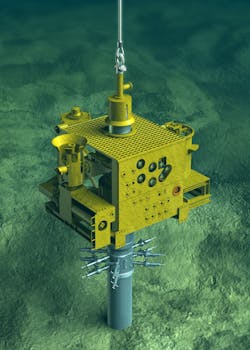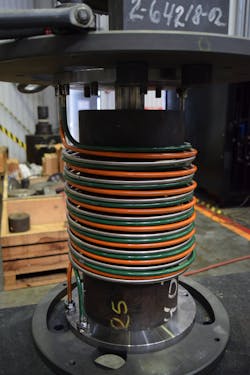Changing the fundamentals of subsea well completion
New tree technology rethinks traditional system design
Judy Murray, Contributing Editor
In early 2016, when the oil price dropped below $30/bbl, the oil and gas industry took a close look at offshore development costs and realized things needed to change. Operators worked with suppliers to achieve cost reductions and cooperated in some cases to share services like crew transfers. Today, with oil prices at a 21-year low, making changes is even more critical, and the solutions that were feasible four years ago are not equal to the task. New technologies and new thinking are needed if offshore developments are going to be economically viable.
Decreasing complexity
According to Dril-Quip CEO Blake DeBerry, delivering better solutions does not mean tweaking components in traditional designs. “It is about rethinking how we do things to deliver permanent cost savings,” he said, “and that means new ideas.”
DeBerry jumpstarted plans for differentiation when he became CEO in 2011. He ramped up the company’s R&D program and invested in full-scale testing of the entire subsea wellhead system.
“This was our first foray into how to develop products that structurally change how customers drill wells offshore,” DeBerry said.
The decision to pursue a different direction for the subsea vertical tree was initiated by a comment from a frustrated operator. The operator’s question was simple: “Why can’t we run the tubing hanger in the wellhead without regard to orientation, lock it down, get a good test and land the tree at any orientation required?
“That was an ‘aha moment,’ DeBerry said. “It seemed to me that, compared to traditional systems, there had to be a simpler and less complicated solution.” DeBerry and his team of 30 engineers and designers began brainstorming about how to land the tubing hanger, and five days later, Dril-Quip filed a provisional patent. “Then, the real work started,” he said.
Designing a better tree
There are several challenges with traditional subsea vertical tree designs. Wellhead interfaces must be capable of handling the stack-up tolerances of casing hangers, and the tubing hanger must be oriented relative to the flowline connection system. Most conventional systems use a tubing head spool, which creates the need for temporary well barriers and additional BOP trips. Alternatively, other complicated means of orienting the tubing hanger within the BOP can be performed, enabling the tubing hanger to be installed directly into the wellhead. Dril-Quip’s new concept needed to simplify the landing and connection processes without introducing additional risks or hazards.
The VXTe system addresses those challenges with the industry’s first non-oriented 15 ksi, in-the-wellhead completion, vertical tree design. This unique tree allows operators to move from drilling to completion without pulling the BOP stack.
One of the most critical design elements of the tree is that it eliminates the tubing head, DeBerry explained. For conventional systems, installing a tubing hanger in the wellhead requires the use of BOP pins, rotational orientation tools or other equipment to align and run the tubing hanger. The Dril-Quip tree system eliminates the need for orientation because the stab sub assembly on the tree allows the tubing hanger to be installed like a casing hanger without regard for orientation and allows drilling and completion to be carried out without temporary well suspension or pulling the BOP stack. It also removes the need for well barriers, which eliminates risk and saves time.
The stab sub-assembly – with 7-in./10 ksi, 5-in./15 ksi, and 5-in./20 ksi ratings – uses the same sealing interface for the stab to the tubing hanger. “A single tubing hanger running tool works for all these systems,” he said.
The coupler body housing element of the stab assembling contains the hydraulic and electric couplers. It can rotate +/- 180 degrees to allow the 13 hydraulic and two electrical coupler lines to connect to the corresponding couplers in the tubing hanger. This exceeds IOGP specification requirements for nine downhole hydraulic functions and one electrical function, providing optionality for future innovations in smart completions that could require more downhole lines.
Automatic space-out adjustment is another design advantage, DeBerry said. The tubing hanger of the VXTe contains a mechanism to automatically adjust to variances in the hanger’s position.
When the tubing hanger is landed, a pressure test verifies the hanger is in the correct position. Then, a hanger lock mandrel is placed with a tubing hanger running tool, creating a flat lock mandrel-to-lock ring interface. “The tubing hanger can be picked up and loaded against the shoulders of the wellhead to establish a known elevation, and the VXTe tubing hanger adjustment mechanism automatically activates and removes any gaps,” he said.
A 15-ksi rated annulus isolation valve inside the tubing hanger provides a reliable barrier in place of a wireline plug for installation and interventions. The annulus flow path isolates the hydraulic and electrical couplers, which protects the wellhead gasket from contact with the annulus fluid and adds another barrier between the annulus fluid and the environment.
The ingenuity of the VXTe system earned it a Spotlight on New Technology Award from the 2020 Offshore Technology Conference (OTC).
Capturing costs
“We are proud of the elegant engineering and what that delivers to the end user,” DeBerry said, explaining that the innovative design eliminates multiple steps in the installation process and reduces the time from FID to first oil production. “Being able to eliminate steps is as valuable as reducing capex. A 10% reduction in capex and a 10% reduction in time have a similar impact on the breakeven point.”
According to DeBerry, one operator calculating the potential value of Dril-Quip’s VXTe in terms of reduced installation time estimated savings at $3 million to $4 million per development well. “The Dril-Quip design can deliver savings of $30 million to $40 million on a 10-well drilling program – and that’s meaningful,” DeBerry said.
The interesting thing about the economics, he said, is that when rig rates go up, the value of installing the VXTe goes up. “If the spread cost is $600,000 per day, and this technology saves a day and a half, it has delivered $900,000 in savings. If the spread cost is $1 million, the same product delivers $1.5 million in value.”
Additional savings can be captured by sequencing the drilling program differently because running the tubing hanger is exactly like running the casing hanger. “Our objective is to manufacture a tubing hanger in the same lead time as a wellhead so when we mobilize rigs to the drill site, the installation process is streamlined. There is no rig remobilization. And if I can push drilling closer to the time I’m going to complete the well, it improves IRR because the money has been spent in a narrower window,” he said.
Taking risks out of the equation
While time and cost savings were critical design considerations, according to DeBerry, minimizing safety risks was also a “must have” for the new vertical tree. The ideal solution would reduce the amount of required hardware and necessary trips and keep workers out of harm’s way.
“A seasoned worker told me when I started in this industry, ‘Don’t ever run something down the hole if you don’t have to,’” he said. “If you eliminate running things, you eliminate risk.”
This was the primary driver for a design that simplifies the installation process, eliminating placing pins in the BOP stack to orient the tubing hanger or having to install a tubing spool, which requires a 40-ton piece of hardware to be maneuvered into place.
Removing components and shortening the installation process also delivers environmental gains.
“ESG (environmental, social and corporate governance) is important for our industry,” DeBerry said, “so our designs are created with the goal of reducing waste and carbon footprint in any way we can.” By designing a vertical tree that does not use a tubing spool, the company has eliminated 40 tons of steel and the associated cost of manufacturing it, moving it, and installing it. The reduction in hardware and tooling within the VXTe eliminates more than 30,000 HSE heavy lift touch points.
“By itself, it isn’t huge, but every little bit helps,” DeBerry says. “Although there is a lot of focus toward renewables, oil and gas will be around for a long time. We need affordable, reliable energy, and we should put the least amount of carbon into the atmosphere to get it.”
The value of standardization
The introduction of the VXTe sets new expectations for flexibility and efficiency, DeBerry says, delivering a product that provides standard functionality with exceptional benefits and allows predictability in installation. This sets an expectation for operators by standardizing installation and improving project economics through enhanced delivery schedules, reduction in engineering, manufacturing and installation costs, and less risk in project execution.
Dril-Quip intends to standardize the VXTe with a single tubing hanger with multiple ports, some of which will be plugged if they are not required. This will allow the company to deliver the tubing hanger with the other wellhead equipment more quickly, he said.
Making this shift requires a willingness on the part of operators to reevaluate some of the components they used to have tailor made, DeBerry said, but the savings in time and installation will be strong drivers for adoption.
Dril-Quip has sold the first VXTe tree which is scheduled for installation at year-end. “What Dril-Quip is doing is something totally different,” DeBerry said, “we are fundamentally changing the norm for the industry.” •

